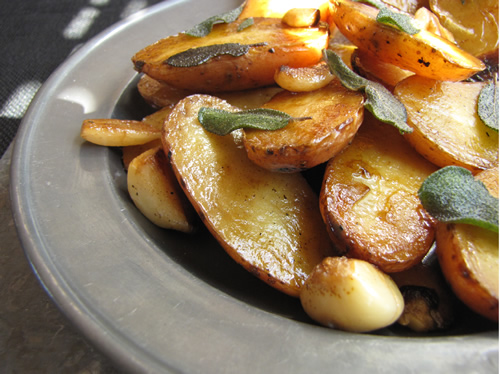If you listen to conventional wisdom, you might think roasting is the only way to go when it comes to cooking fingerling potatoes. Now, I am usually the poster-girl for roasting (potatoes or anything else), and I’d like not to be burned at the stake for potato heresy, but I think fingerling potatoes are usually better braised or simmered, or, yes, boiled—any method that involves a little liquid.
I hate to generalize, because there are, in fact, many different varieties of fingerling potatoes. Fingerlings themselves aren’t a variety, but more of a type of potato, defined by their size and shape—small, knobby, and elongated. Their flavor is usually rich and concentrated, but the color of their skin and flesh, as well as their starch content, can vary quite a bit from variety to variety. (Popular varieties include Russian Banana, Purple Peruvian, Ruby Crescent, and French Fingerling.)
The varying starch level is why some fingerlings lean towards being fluffy and dry (like a Russet potato), while others have creamy or waxy flesh (like a Red Bliss potato). Unless you cook with the same variety a lot, it’s hard to always know exactly what you’re getting at the store (or the farmers’ market) or how it will behave in the dry heat of the oven. While I’ve had bad experiences with Russian Bananas over-drying when roasted, I’ve never had a fingerling that wasn’t perfectly delicious when cooked with a wet-heat method.
That’s why I love a stovetop braise for fingerlings. First you brown the halved potatoes cut-side down in a little butter and olive oil so that they get that nice caramel color and flavor. Then you pour a bit of chicken broth over them and cover the pan (a straight-sided saute pan works best here). As the potatoes finish cooking in the broth, the broth simmers down to a bit of a glazey consistency. The recipe I’ve included here uses sage and garlic to add more flavor, but fingerlings cooked this way are delicious even without the extras.
And if you love fingerlings so much that you need more ideas for using them, see my post on more delicious ideas for using fingerlings.
Braised Fingerlings with Crispy Sage & Tender Garlic
For this dish, choose fingerlings that are all about the same thickness (length doesn’t matter) so that they will all cook in about the same amount of time.
Serves 3
—————————————————————————————–
1 tablespoon unsalted butter
1 tablespoon extra-virgin olive oil
25 large sage leaves
8 garlic cloves, lightly smashed and peeled
12 ounces (about six to eight) fingerling potatoes, cut in half lengthwise
½ teaspoon kosher salt, more for seasoning
½ cup low-sodium chicken broth
½ to 1 teaspoon sherry or malt vinegar
—————————————————————————————–
In a large (10-inch) straight-sided skillet with a lid, heat the butter and olive oil over medium-high heat. When the butter has melted and is foaming, add the sage leaves and cook, stirring a bit, until the sage leaves have turned color and are crispy and the butter is golden brown, about 2 minutes. (Watch carefully so that they don’t burn; they will stiffen and curl and turn grey as they crisp up.) Remove the pan from the heat and transfer the sage leaves with a fork or tongs to a plate.
Put the pan back over medium to medium-high heat and immediately add the garlic and potatoes. Season them with the ½ teaspoon salt and toss them in the butter/oil mixture. Arrange the potatoes cut side down, cover the pan loosely with the lid (leaving the lid a bit askew for some steam to escape), and cook until the bottoms of the potatoes are nicely browned, 8 to 10 minutes. (Move the pan around occasionally for even browning.)
Add the chicken broth and cover with the lid partially askew again. Bring the broth to a gentle simmer and cook until the broth has reduced to just a tablespoon or two, about 10 to 15 minutes. Remove the lid, turn the heat off, and transfer the potatoes and garlic to a serving dish. Add the vinegar to the pan and stir and scrape with a wooden spoon to get up any browned bits. Immediately pour the pan drippings over the potatoes and garlic and garnish with the crispy sage leaves. Sprinkle a little more kosher salt over all.


3 thoughts on “What Fingerling Potatoes Want: Something Saucy”
Comments are closed.